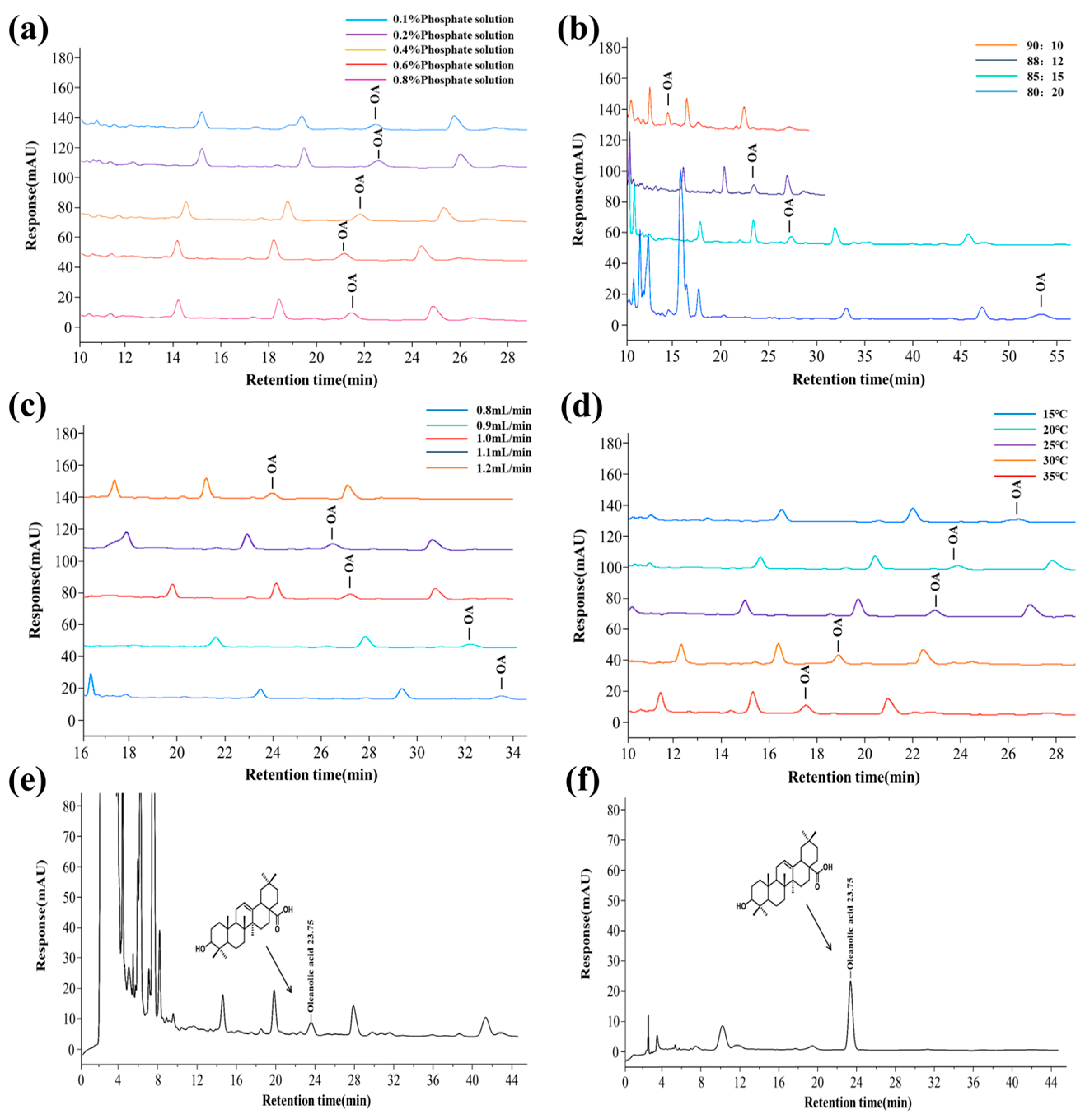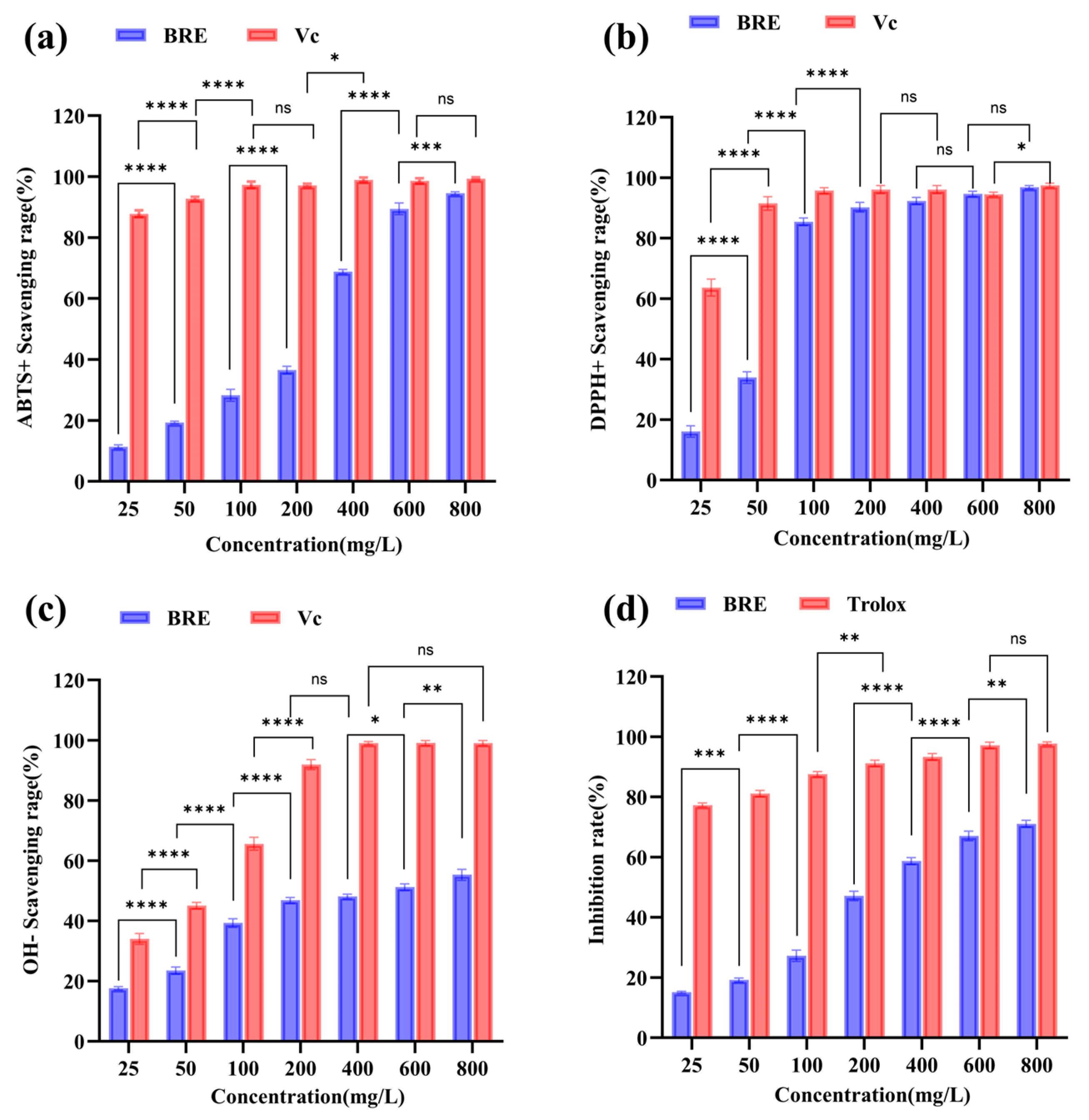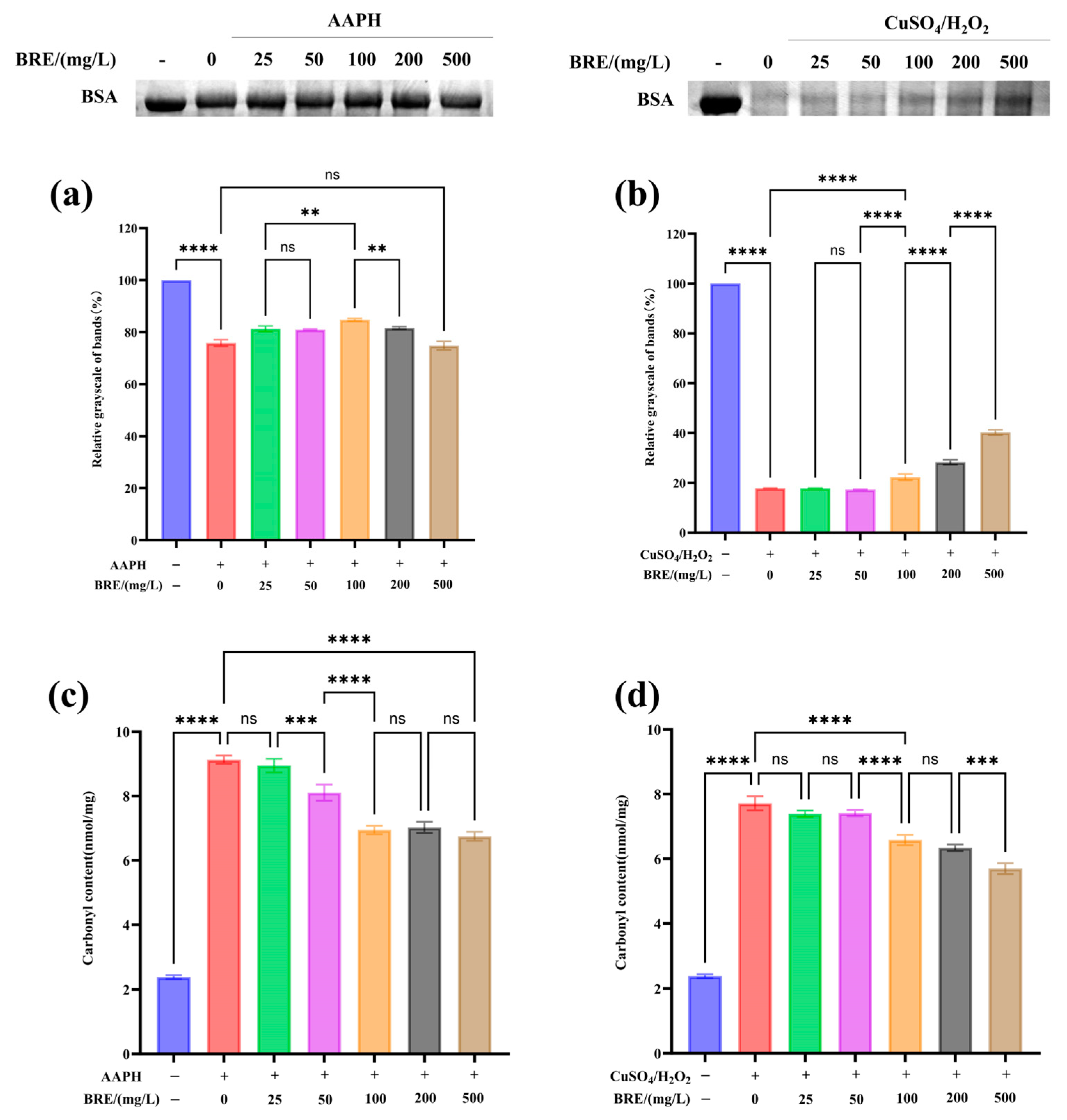The Protective Effect of Boschnikia rossica Extract on Free Radical-Induced Oxidative Damage of Biomolecules and Establishment of a Method for Determining the Content of Oleanolic Acid
Abstract
1. Introduction
2. Materials and Methods
2.1. Materials and Reagents
2.2. Preparation of BRE
2.3. Preparation of Standard Samples of OA
2.4. Establishment and Methodological Study of RP-HPLC Analysis Method
2.4.1. Optimization of Chromatographic Separation Conditions
2.4.2. Methodological Testing
2.5. Antioxidant Activity of BRE In Vitro
2.5.1. ABTS Free Radical Scavenging Test
2.5.2. DPPH Radical Scavenging Test
2.5.3. Hydroxyl Radical Scavenging Test
2.5.4. Determination of β-Carotene Bleaching Inhibition
2.6. Effect of BRE on Free Radical-Induced Protein Oxidative Damage
2.6.1. Effect of BRE on CuSO4/H2O2-Induced Protein Oxidation and Carbonylation
2.6.2. Effects of Boschnikia rossica Extract on Protein Oxidation and Carbonylation Induced by AAPH
2.7. Effect of BRE on Free Radical-Induced Lipid Peroxidation
2.7.1. Effect of BRE on FeSO4-Induced Oxidation of LA
2.7.2. Effect of BRE on Oxidation of LA Induced by AMVN
2.8. The Effect of BRE on Free Radical-Induced DNA Oxidative Damage
2.8.1. The Effect of BRE on AAPH-Induced DNA Oxidative Damage
2.8.2. Effect of BRE on CuSO4/H2O2-Induced DNA Oxidative Damage
2.8.3. Determination of hsDNA Oxidative Damage
2.8.4. DNA Agarose Gel Electrophoresis
2.9. BRE Component Determination
2.10. Statistical Analysis
3. Results and Discussion
3.1. Optimization of Separation Conditions for HPLC
3.2. Methodological Investigation and Sample Content Determination of RP-HPLC
3.2.1. Linear Range, Correlation Coefficient, and Detection Limit
3.2.2. Stability, Repeatability, Precision, and Spiked Recovery Experimental Results
3.3. BRE In Vitro Antioxidant Activity
3.3.1. BRE’s Free Radical Scavenging Ability
3.3.2. Inhibition Ability of β-Carotene Bleaching
3.4. The Effect of BRE on Free Radical-Induced Protein Oxidative Damage
3.4.1. The Effect of BRE on AAPH-Induced BSA Oxidative Damage
3.4.2. The Effect of BRE on CuSO4/H2O2-Induced BSA Oxidative Damage
3.4.3. Effect of BRE on AAPH- and CuSO4/H2O2-Induced Carbonylation of BSA
3.5. The Effect of BRE on Free Radical-Induced Lipid Peroxidation
3.5.1. The Effect of BRE on AMVN-Induced Lipid Peroxidation
3.5.2. The Effect of BRE on FeSO4-Induced Lipid Peroxidation
3.6. Effect of BRE on Free Radical-Induced DNA Oxidative Damage
3.6.1. The Effect of BRE on AAPH- and CuSO4/H2O2-Induced Oxidative Damage of pBR322 DNA
3.6.2. The Effect of BRE on Oxidative Damage of hsDNA Induced by AAPH and CuSO4/H2O2
4. Conclusions
Supplementary Materials
Author Contributions
Funding
Institutional Review Board Statement
Informed Consent Statement
Data Availability Statement
Conflicts of Interest
References
- Schieber, M.; Chandel, N.S. ROS Function in Redox Signaling and Oxidative Stress. Curr. Biol. 2014, 24, R453–R462. [Google Scholar] [CrossRef]
- Das, N.; Parvin, M.S.; Hasan, M.; Akter, M.; Hossain, M.S.; Parvez, G.M.M.; Sarker, A.K.; Abdur Rahman, M.A.; Mamun, A.; Islam, M.E. A flavone from the ethyl acetate extract of Leea rubra leaves with DNA damage protection and antineoplastic activity. Biochem. Biophys. Rep. 2022, 30, 101244. [Google Scholar] [CrossRef]
- Bera, D.; Lahiri, D.; Nag, A. Studies on a natural antioxidant for stabilization of edible oil and comparison with synthetic antioxidants. J. Food Eng. 2006, 74, 542–545. [Google Scholar] [CrossRef]
- Zhong, Y.; Yuan, X.; Feng, Q.; Wang, Q.; Pan, H.; Qiao, Z.; Wang, T.; Zhuang, Y. Application of polyphenols as natural antioxidants in edible oils: Current status, antioxidant mechanism, and advanced technology. Food Res. Int. 2025, 208, 116234. [Google Scholar] [CrossRef]
- Wu, H.; Zhao, W.; Zhou, J.; Xie, X.; Zhong, X.; Liu, Y.; Shi, L. Extraction, analysis of antioxidant activities and structural characteristics of flavonoids in fruits of Diospyros lotus L. LWT 2024, 201, 116248. [Google Scholar] [CrossRef]
- Rudrapal, M.; Rakshit, G.; Singh, R.P.; Garse, S.; Khan, J.; Chakraborty, S. Dietary Polyphenols: Review on Chemistry/Sources, Bioavailability/Metabolism, Antioxidant Effects, and Their Role in Disease Management. Antioxidants 2024, 13, 429. [Google Scholar] [CrossRef]
- Palanisamy, S.; Vinosha, M.; Marudhupandi, T.; Rajasekar, P.; Prabhu, N.M. Isolation of fucoidan from Sargassum polycystum brown algae: Structural characterization, in vitro antioxidant and anticancer activity. Int. J. Biol. Macromol. 2017, 102, 405–412. [Google Scholar] [CrossRef]
- Liu, Q.; Ge, X.; Chen, L.; Cheng, D.; Yun, Z.; Xu, W.; Shao, R. Purification and analysis of the composition and antioxidant activity of polysaccharides from Helicteres angustifolia L. Int. J. Biol. Macromol. 2018, 107, 2262–2268. [Google Scholar] [CrossRef]
- Quan, J.; Piao, L.; Xu, H.; Li, T.; Yin, X. Protective Effect of Iridoid Glucosides from Boschniakia rossicaon Acute Liver Injury Induced by Carbon Tetrachloride in Rats. Biosci. Biotechnol. Biochem. 2014, 73, 849–854. [Google Scholar] [CrossRef]
- Lin, L.-C.; Lee, L.-C.; Huang, C.; Chen, C.-T.; Song, J.-S.; Shiao, Y.-J.; Liu, H.-K. Effects of boschnaloside from Boschniakia rossica on dysglycemia and islet dysfunction in severely diabetic mice through modulating the action of glucagon-like peptide-1. Phytomedicine 2019, 62, 152946. [Google Scholar] [CrossRef]
- Hu, T.; Li, M.; Zhang, X.; Gao, Y.; Gao, H.; Liu, L.; Zuo, A.; Wang, Y.; Guo, J.; Zheng, Y. Combination of mass spectrometry analysis and bioinformatic analysis for characterizing anti-inflammation active components from Boschniakia rossica and the targets. J. Chromatogr. A 2025, 1739, 465544. [Google Scholar] [CrossRef]
- Choi, J.K.; Kim, S.-W.; Kim, D.-S.; Lee, J.Y.; Lee, S.; Oh, H.-M.; Ha, Y.S.; Yoo, J.; Park, P.-H.; Shin, T.-Y.; et al. Oleanolic acid acetate inhibits rheumatoid arthritis by modulating T cell immune responses and matrix-degrading enzymes. Toxicol. Appl. Pharmacol. 2016, 290, 1–9. [Google Scholar] [CrossRef]
- Zhang, W.; Feng, J.; Cheng, B.; Lu, Q.; Chen, X. Oleanolic acid protects against oxidative stress-induced human umbilical vein endothelial cell injury by activating AKT/eNOS signaling. Mol. Med. Rep. 2018, 18, 3641–3648. [Google Scholar] [CrossRef]
- Zhou, Z.; Dong, Y.; Li, N.; Niu, M.; Wang, S.; Zhou, Y.; Sun, Z.; Chu, P.; Tang, Z. An oleanolic acid derivative, K73-03, inhibits pancreatic cancer cells proliferation in vitro and in vivo via blocking EGFR/Akt pathway. Cell Biol. Int. 2022, 46, 1801–1813. [Google Scholar] [CrossRef]
- Wan, X.-L.; Lu, Y.-F.; Xu, S.-F.; Wu, Q.; Liu, J. Oeanolic acid protects against the hepatotoxicity of D-galactosame plus endotoxin in mice. Biomed. Pharmacother. 2017, 93, 1040–1046. [Google Scholar] [CrossRef]
- Adjei, S.; Amponsah, I.K.; Bekoe, S.O.; Harley, B.K.; Mensah, K.B.; Mensah, A.Y.; Baah, M.K.; Fosu-Mensah, G. Fruits of Vitex doniana sweet: Toxicity profile, anti-inflammatory and antioxidant activities, and quantification of one of its bioactive constituents oleanolic acid. Heliyon 2021, 7, e07910. [Google Scholar] [CrossRef]
- Xu, X.-H.; Su, Q.; Zang, Z.-H. Simultaneous determination of oleanolic acid and ursolic acid by RP-HPLC in the leaves of Eriobotrya japonica Lindl. J. Pharm. Anal. 2012, 2, 238–240. [Google Scholar] [CrossRef]
- Peñafiel, C.C.; Díaz Villar, L. Spectrophotometric determination of oleanolic acid and saponins from quinoa (Chenopodium quinoa Willd, Kancolla variety). Arch. Latinoam. Nutr. 1988, 38, 113–131. [Google Scholar]
- Nag, M.; Kar, A.; Chanda, J.; Mukherjee, P.K. RP-HPLC analysis of methanol extract of Viscum articulatum. J. Ayurveda Integr. Med. 2020, 11, 277–280. [Google Scholar] [CrossRef]
- Abdelouhab, K.; Guemmaz, T.; Karamać, M.; Kati, D.E.; Amarowicz, R.; Arrar, L. Phenolic composition and correlation with antioxidant properties of various organic fractions from Hertia cheirifolia extracts. J. Pharm. Biomed. Anal. 2023, 235, 115673. [Google Scholar] [CrossRef]
- Miliauskas, G.; Venskutonis, P.R.; van Beek, T.A. Screening of radical scavenging activity of some medicinal and aromatic plant extracts. Food Chem. 2004, 85, 231–237. [Google Scholar] [CrossRef]
- Pu, X.; Ma, X.; Liu, L.; Ren, J.; Li, H.; Li, X.; Yu, S.; Zhang, W.; Fan, W. Structural characterization and antioxidant activity in vitro of polysaccharides from angelica and astragalus. Carbohydr. Polym. 2016, 137, 154–164. [Google Scholar] [CrossRef]
- Bhattacharyya, S.; Samanta, S.; Hore, M.; Barai, S.; Dash, S.K.; Roy, S. Phytochemical compositions, antioxidant, anticholinesterase, and antibacterial properties of Clerodendrum thomsoniae Balf.f. leaves: In vitro and in silico analyses. Pharmacol. Res. Nat. Prod. 2024, 5, 100121. [Google Scholar] [CrossRef]
- Kumar, V.; Sharma, M.; Lemos, M.; Shriram, V. Efficacy of Helicteres isora L. against free radicals, lipid peroxidation, protein oxidation and DNA damage. J. Pharm. Res. 2013, 6, 620–625. [Google Scholar] [CrossRef]
- Kawai, Y.; Fujii, H.; Okada, M.; Tsuchie, Y.; Uchida, K.; Osawa, T. Formation of Nɛ-(succinyl)lysine in vivo: A novel marker for docosahexaenoic acid-derived protein modification. J. Lipid Res. 2006, 47, 1386–1398. [Google Scholar] [CrossRef]
- Zelena, E.; Dunn, W.B.; Broadhurst, D.; Francis-McIntyre, S.; Carroll, K.M.; Begley, P.; O’Hagan, S.; Knowles, J.D.; Halsall, A.; Wilson, I.D.; et al. Development of a robust and repeatable UPLC-MS method for the long-term metabolomic study of human serum. Anal. Chem. 2009, 81, 1357–1364. [Google Scholar] [CrossRef]
- Want, E.J.; Masson, P.; Michopoulos, F.; Wilson, I.D.; Theodoridis, G.; Plumb, R.S.; Shockcor, J.; Loftus, N.; Holmes, E.; Nicholson, J.K. Global metabolic profiling of animal and human tissues via UPLC-MS. Nat. Protoc. 2013, 8, 17–32. [Google Scholar] [CrossRef]
- Stephenus, F.N.; Benjamin, M.A.Z.; Anuar, A.; Awang, M.A. Effect of Temperatures on Drying Kinetics, Extraction Yield, Phenolics, Flavonoids, and Antioxidant Activity of Phaleria macrocarpa (Scheff.) Boerl. (Mahkota Dewa) Fruits. Foods 2023, 12, 2859. [Google Scholar] [CrossRef]
- Ornelas-Paz, J.d.J.; Martínez-Burrola, J.M.; Ruiz-Cruz, S.; Santana-Rodríguez, V.; Ibarra-Junquera, V.; Olivas, G.I.; Pérez-Martínez, J.D. Effect of cooking on the capsaicinoids and phenolics contents of Mexican peppers. Food Chem. 2010, 119, 1619–1625. [Google Scholar] [CrossRef]
- Xue, Y.; Wang, F.; Zhou, C. Optimization of Ultrasonic Extraction of Triterpenes from Loquat Peel and Pulp and Determination of Antioxidant Activity and Triterpenoid Components. Foods 2022, 11, 2563. [Google Scholar] [CrossRef]
- Ma, W.; Shi, Y.; Yang, G.; Shi, J.; Ji, J.; Zhang, Y.; Wang, J.; Peng, Q.; Lin, Z.; Lv, H. Hypolipidaemic and antioxidant effects of various Chinese dark tea extracts obtained from the same raw material and their main chemical components. Food Chem. 2022, 375, 131877. [Google Scholar] [CrossRef]
- Sihag, S.; Pal, A.; Ravikant; Saharan, V. Antioxidant properties and free radicals scavenging activities of pomegranate (Punica granatum L.) peels: An in-vitro study. Biocatal. Agric. Biotechnol. 2022, 42, 102368. [Google Scholar] [CrossRef]
- Jomova, K.; Alomar, S.Y.; Valko, R.; Liska, J.; Nepovimova, E.; Kuca, K.; Valko, M. Flavonoids and their role in oxidative stress, inflammation, and human diseases. Chem. Biol. Interact. 2025, 413, 111489. [Google Scholar] [CrossRef]
- Moukette, B.M.; Pieme, C.A.; Njimou, J.R.; Biapa, C.P.N.; Marco, B.; Ngogang, J.Y. In vitro antioxidant properties, free radicals scavenging activities of extracts and polyphenol composition of a non-timber forest product used as spice: Monodora myristica. Biol. Res. 2015, 48, 15. [Google Scholar] [CrossRef]
- Belounis, Y.; Moualek, I.; Sebbane, H.; Ait Issad, H.; Saci, S.; Saoudi, B.; Nabti, E.-h.; Trabelsi, L.; Houali, K.; Cruz, C. Potential Natural Antioxidant and Anti-Inflammatory Properties of Carthamus caeruleus L. Root Aqueous Extract: An In Vitro Evaluation. Processes 2025, 13, 878. [Google Scholar] [CrossRef]
- Lin, L.; Yin, Y.; Hou, G.; Han, D.; Kang, J.; Wang, Q. Ursolic acid attenuates cigarette smoke-induced emphysema in rats by regulating PERK and Nrf2 pathways. Pulm. Pharmacol. Ther. 2017, 44, 111–121. [Google Scholar] [CrossRef]
- Ji, R.; Jia, F.Y.; Chen, X.; Wang, Z.H.; Jin, W.Y.; Yang, J. Salidroside alleviates oxidative stress and apoptosis via AMPK/Nrf2 pathway in DHT-induced human granulosa cell line KGN. Arch. Biochem. Biophys. 2022, 715, 109094. [Google Scholar] [CrossRef]
- Kulisic, T.; Radonic, A.; Katalinic, V.; Milos, M. Use of different methods for testing antioxidative activity of oregano essential oil. Food Chem. 2004, 85, 633–640. [Google Scholar] [CrossRef]
- Ghimire, A.; Paudel, N.; Poudel, R. Effect of pomegranate peel extract on the storage stability of ground buffalo (Bubalus bubalis) meat. LWT 2022, 154, 112690. [Google Scholar] [CrossRef]
- Zhang, J.; Hou, X.; Ahmad, H.; Zhang, H.; Zhang, L.; Wang, T. Assessment of free radicals scavenging activity of seven natural pigments and protective effects in AAPH-challenged chicken erythrocytes. Food Chem. 2014, 145, 57–65. [Google Scholar] [CrossRef]
- Procházková, D.; Boušová, I.; Wilhelmová, N. Antioxidant and prooxidant properties of flavonoids. Fitoterapia 2011, 82, 513–523. [Google Scholar] [CrossRef] [PubMed]
- Lipinski, B. Hydroxyl Radical and Its Scavengers in Health and Disease. Oxidative Med. Cell. Longev. 2011, 2011, 809696. [Google Scholar] [CrossRef] [PubMed]
- Xie, Z.; Zhai, Y.; Zhang, Y.; He, M.; Wang, X.; Yu, S.; Xiao, H.; Song, Y. Antioxidant and anti-HepG2 cell activities of a novel bioactive peptide from cowhide collagen in vitro. J. Future Foods 2024, 4, 248–257. [Google Scholar] [CrossRef]
- Estévez, M. Protein carbonyls in meat systems: A review. Meat Sci. 2011, 89, 259–279. [Google Scholar] [CrossRef] [PubMed]
- Fedorova, M.; Bollineni, R.C.; Hoffmann, R. Protein carbonylation as a major hallmark of oxidative damage: Update of analytical strategies. Mass Spectrom. Rev. 2013, 33, 79–97. [Google Scholar] [CrossRef]
- Gobert, M.; Rémond, D.; Loonis, M.; Buffière, C.; Santé-Lhoutellier, V.; Dufour, C. Fruits, vegetables and their polyphenols protect dietary lipids from oxidation during gastric digestion. Food Funct. 2014, 5, 2166. [Google Scholar] [CrossRef]
- Vieira, J.d.S.; de Oliveira, V.S.; Carneiro, M.J.; da Silva, T.L.; Augusta, I.M.; de Carvalho, M.G.; Sawaya, A.C.H.F.; Saldanha, T. Phenolic composition and insights into the use of pink pepper (Schinus terebentifolius Raddi) fruit against lipid oxidation in food systems. Food Biosci. 2023, 53, 102556. [Google Scholar] [CrossRef]
- Loussouarn, M.; Krieger-Liszkay, A.; Svilar, L.; Bily, A.; Birtić, S.; Havaux, M. Carnosic Acid and Carnosol, Two Major Antioxidants of Rosemary, Act through Different Mechanisms. Plant Physiol. 2017, 175, 1381–1394. [Google Scholar] [CrossRef]
- Yates, K.; Pohl, F.; Busch, M.; Mozer, A.; Watters, L.; Shiryaev, A.; Kong Thoo Lin, P. Determination of sinapine in rapeseed pomace extract: Its antioxidant and acetylcholinesterase inhibition properties. Food Chem. 2019, 276, 768–775. [Google Scholar] [CrossRef]





| Serial Number | Peak Area (mAU·s) | Quantity Contained (mg/L) | Average Content (mg/L) | RSD/% |
|---|---|---|---|---|
| 1 | 402.16 | 178.31 | 179.13 | 1.45 |
| 2 | 408.37 | 181.08 | ||
| 3 | 397.65 | 176.31 | ||
| 4 | 402.12 | 178.29 | ||
| 5 | 400.17 | 177.43 | ||
| 6 | 413.52 | 183.38 |
| Times/h | 0 | 2 | 4 | 8 | 12 | 24 | RSD/% |
|---|---|---|---|---|---|---|---|
| peak area (mAU·s) | 412.73 | 405.85 | 410.21 | 399.75 | 402.16 | 403.78 | 1.21 |
| Serial Number | Quantity Contained (mg/L) | Marked Quantity(mg/L) | Measured Content (mg/L) | Recovery Rate/% | Average Recovery Rate/% | RSD/% |
|---|---|---|---|---|---|---|
| 1 | 178.31 | 50 | 226.46 | 96.30% | 98.88% | 0.95 |
| 2 | 178.31 | 50 | 229.18 | 101.74% | ||
| 3 | 181.47 | 50 | 230.77 | 98.60% | ||
| 4 | 177.29 | 100 | 278.33 | 101.04% | 101.46% | 0.69 |
| 5 | 177.87 | 100 | 276.86 | 98.99% | ||
| 6 | 176.31 | 100 | 280.66 | 104.35% | ||
| 7 | 178.31 | 200 | 376.66 | 99.18% | 100.95% | 1.25 |
| 8 | 181.47 | 200 | 386.13 | 102.33% | ||
| 9 | 177.87 | 200 | 380.55 | 101.34% |
Disclaimer/Publisher’s Note: The statements, opinions and data contained in all publications are solely those of the individual author(s) and contributor(s) and not of MDPI and/or the editor(s). MDPI and/or the editor(s) disclaim responsibility for any injury to people or property resulting from any ideas, methods, instructions or products referred to in the content. |
© 2025 by the authors. Licensee MDPI, Basel, Switzerland. This article is an open access article distributed under the terms and conditions of the Creative Commons Attribution (CC BY) license (https://creativecommons.org/licenses/by/4.0/).
Share and Cite
Zhao, Z.; Jia, M.; An, Y.; Bao, Y.; Zhao, Y. The Protective Effect of Boschnikia rossica Extract on Free Radical-Induced Oxidative Damage of Biomolecules and Establishment of a Method for Determining the Content of Oleanolic Acid. Foods 2025, 14, 1658. https://doi.org/10.3390/foods14101658
Zhao Z, Jia M, An Y, Bao Y, Zhao Y. The Protective Effect of Boschnikia rossica Extract on Free Radical-Induced Oxidative Damage of Biomolecules and Establishment of a Method for Determining the Content of Oleanolic Acid. Foods. 2025; 14(10):1658. https://doi.org/10.3390/foods14101658
Chicago/Turabian StyleZhao, Zhuohao, Mingjie Jia, Yuning An, Yihong Bao, and Yuncai Zhao. 2025. "The Protective Effect of Boschnikia rossica Extract on Free Radical-Induced Oxidative Damage of Biomolecules and Establishment of a Method for Determining the Content of Oleanolic Acid" Foods 14, no. 10: 1658. https://doi.org/10.3390/foods14101658
APA StyleZhao, Z., Jia, M., An, Y., Bao, Y., & Zhao, Y. (2025). The Protective Effect of Boschnikia rossica Extract on Free Radical-Induced Oxidative Damage of Biomolecules and Establishment of a Method for Determining the Content of Oleanolic Acid. Foods, 14(10), 1658. https://doi.org/10.3390/foods14101658






